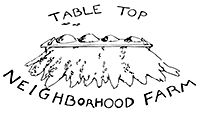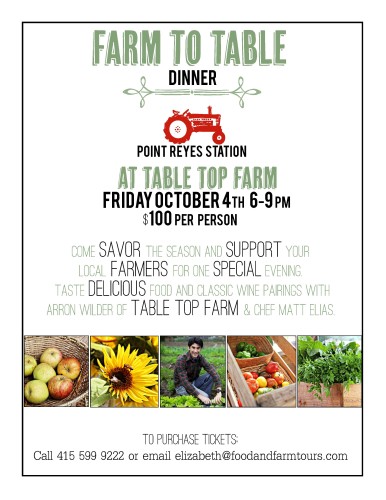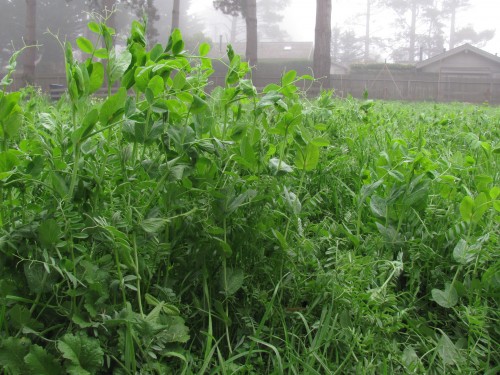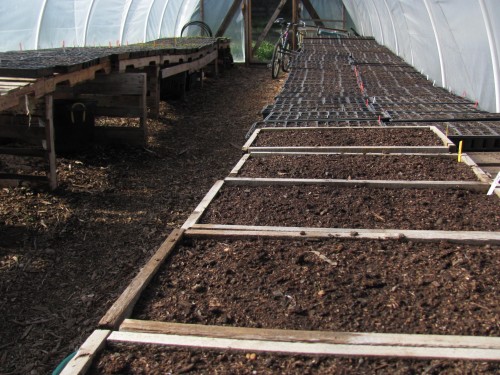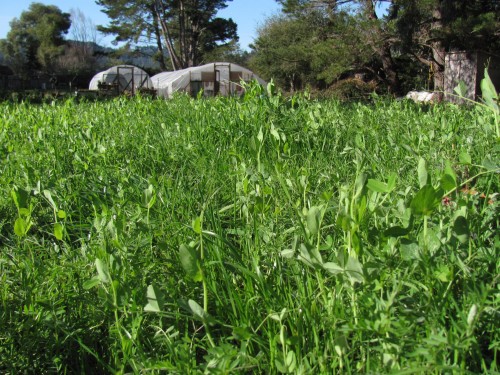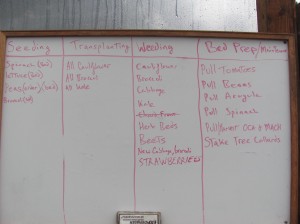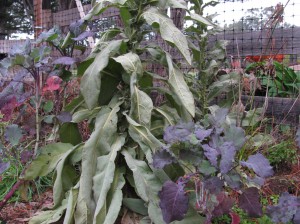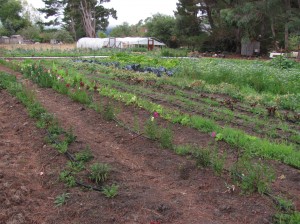June 2013 – New fields, new soil
We’ve been busy tending the fields. This year we have two new ones planted – Black Mountain Ranch and Mcdonald Lane. Here are a few photos from each spot:

Lots of plants that we all planted during the early June potato planting party. They are all maturing so nicely!
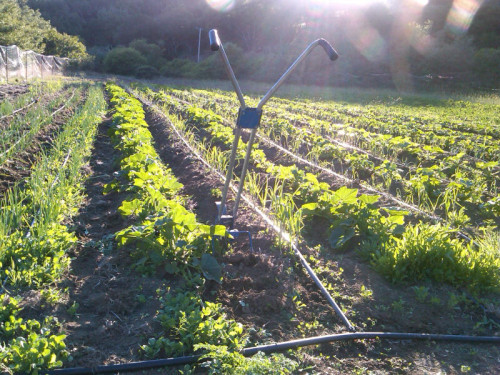
Wheel hoeing in the winter squash plants and leeks
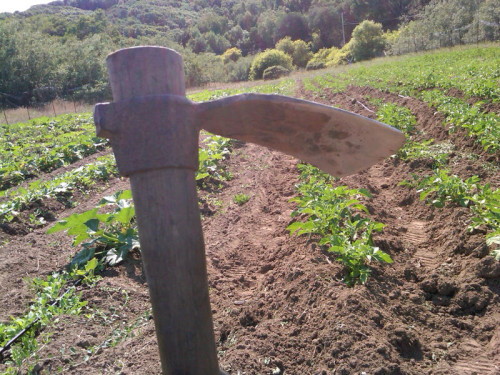
My favorite hand tool – the digging hoe. I obtained this from a man in Ecuador who hand-forged it from handmade steel

Our newest plot on Mcdonald lane – Mickey D’s! Newly plowed field planting kale and chard, amongst other things

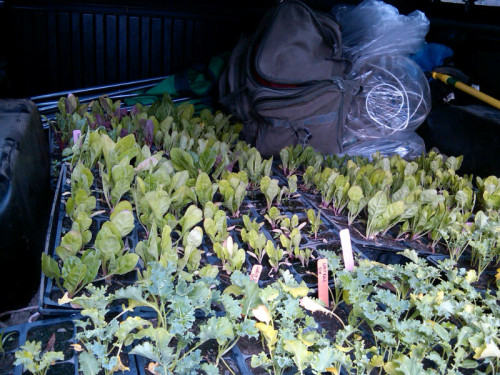
Our transplants ready to go into the field, awaiting removal from the truck bed
Potato Planting Party June 2013
Last weekend we had our first work party of 2013. About 10 people came together on a warm Saturday morning and afternoon to lend a hand and show support of our small organic farm. Thanks so much for all the hard work and fun! We planted 150 pounds of seed potatoes, about 600 squash plants, and several thousand onions. It felt great to be part of a team working together and by the end of the day, we all were excited to maybe do it again, soon.
Planning season and strawberry fields forever

It’s that time of year when the work on the farm is slowly ramping up. It is planning time, seeding time, mulching time, tool-cleaning and sharpening time, compost making time, and organizing time. But it is also weeding time, watering time, and time to make sure the basics are in: the fence is up, the watering system is ready, the tractor is maintained. Soon it will be time to cut down the grass, till up the soil, transplant the first round of plants from the greenhouse, and seed the first round of seeds in the soil.
Already, we’ve started to cut back some of the very thickly growing cover crop to make room for about 700 strawberry plants that will be going into the ground within 2 weeks. Most of these plants were collected last year from runners that grew from the first round of planting, which were collected from runners from the previous year’s crop. We’re slowly expanding our strawberry area and hope to in a year or so have about half the 1/2-acre plot be strawberries.
Emphasis here is on the word “slow”. I really liked Joel Salatin’s Dad’s saying about how “it’s so easy to drive up ahead of your headlights”. With farming, that seems like such an apt metaphor, because the tendency in the beginning of the season is to over plant and generally bite off more than you can chew. It happens so often. But with living things that have specific needs, sometimes the ball gets dropped and an entire batch of something doesn’t make it into the ground, or doesn’t get weeded, watered, or even harvested! There just isn’t enough time to do it all, sometimes. Plus, on a farm, there are so many unknowns and nothing is certain. It’s very easy to sit down with a piece of paper, surrounded by 4 walls and a roof, and draw out a plan for the farm. Even better, make some spreadsheets, or use some fancy farm planning software, and soon enough, golly – that farm plan sure does look polished and crisp. Its gonna be a good year! But its a whole different world out there in the wilderness of bugs and slugs and soil and ice, floods, searing sun, high winds, raccoons, possums, birds, deer, and gophers. Where it’s so often simply a combination of good timing, good luck, and experience (in that order) that makes it work.
With something like strawberries, its hard to invest lots of space, time, money and other more intangibles like hope and excitement, only to find that they don’t do so well in our soil or that they get a disease and die, or that we can’t sell them because they’ve all got little chunks eaten out of them by bugs. Luckily, we’ve been trying a whole lot of different things and although we have had some problems with strawberries (as in its not hot enough and they don’t do really well in our climate and the slugs love them as much as we do), we like them nevertheless and it seems like a thing worth dedicating some more space to. Also, it is well known that after about the second year, their yields really do take off for about 2 years. We haven’t even surpassed one year yet with our strawberry patch, so this will be new territory for us with the strawberries.
We spent a lot of effort just deciding which variety would be most suitable. Prior to about 10-15 years ago, there was only really one type of strawberry – what are known as June bearing. And then someone at a university in the midwest got the idea to breed this type with a wild variety and the “everbearing” strawberry was born. The great thing about the June bearing varieties is the unbeatable taste – there’s not much comparison. But they all ripen within 2-3 weeks and then they’re done for the rest of the season. The everbearing varieties, on the other hand, still taste amazing and bear at a more gentle rate and for months instead of for a couple of weeks. So we went with the everbearing variety and these seem to be right for us.
We’ve trialed the “Cameron” variety, the “Seascape” variety and the “Albion” variety. The Albion seemed to do the best, so we’ve stuck with them. The others were tasty, but not as vigorous. The first season’s fruit of the Seascape was incredible and delicious, but it didn’t bear as much over a period of time and was more similar to the June bearing. Albion had a tart and sweet flavor, was resistant to most disease (we didn’t get any diseases…keeping our fingers crossed), and the plants were overall very hardy. We do tend to not pamper our plants, so hardiness is a very good attribute. One problem for us though, is slugs. We tend to pick the strawberries a bit on the tart side because if we wait just 6-8 hours, they’ll be slug food. Somehow, the slugs have really good taste in strawberries, and like them best when they are ripe – just like us. We also try to pick them in the morning. Supposedly, they last longest if picked early in the morning, and they taste sweetest when picked mid-day (although they don’t last very long). Since they still taste delicious in the morning and they last longer, we go with this method. Additionally, this year we may experiment with a groundbreaking new method for protecting them from mold: hot water. If sprayed with hot water, strawberries (and other berries) will last several days longer due to the decrease in molds and bacteria on the berries. I wonder if the hot water washes off the berries delicious taste? We’ll have to do some taste tests this year to find out.
Mid-February 2013 – Wind and seeds
This time of year, understanding what the weather is going to do can be tricky. Two days ago, spring felt like it had arrived! It was warm. It had been warm all week. Yesterday though, I had to wear two sweatshirts and a wool hat and I was still cold. The wind started blowing and the air became thinner. Warm blasts were followed minutes later by frigid, arctic air, until it was only cold wind blowing. Wind means spring though. And visa versa. Luckily at the farm on Cypress Street, we have two rows of tall wind break trees situated at the northern side. There is also a row of pines that lines the southern portion of the land. This line of trees is hardly a wind break though, and really only does the dis-service of blocking the sunlight. Most of the damaging winds seem to come down the bay from the north. Two years ago, working at the Heidrun Meadery on Viento Street (which means wind), it was incredibly blustery between late February and April. No surprise there. But at the end of the day working out in the field, I felt totally drained. It takes twice as much energy to work out in the wind. Now, even though we can’t feel the wind as strongly when we’re out working in it (which is a good thing!), we know that it is windy and that wind means it is spring around here.
We did a lot of seeding in the greenhouse this weekend. We seed into 48-cell flats. So far, I like the 48-cell flats as opposed to the 72-cell flats, because I can’t always be there the day the plants need to get transplanted. With the 72-cell flats, when they are ready, they’re ready! And they have to be transplanted right away. But with the 48-cell flats, there’s a couple more weeks of wiggle room, in case things get busy. Here is a list of what we have in the seedling greenhouse: flat of Italy parsley, rainbow chard, fordhook giant chard, red russian kale, blue scotch curley kale, elephant dill, slo-bolt cilantro, tom thumb lettuce, utah celery, tendercrisp celery, and the list goes on.
We also planted about 20,000 onion seeds (yellow of parma and red long of tropea), and about 20,000 leek seeds in the big greenhouse, directly into the ground. In about 2 months, these alliums will grow to about 1/4 inch in diameter before they are dug up and transplanted out to the farm at Black Mountain Ranch. The tomatoes will follow the onion starts in May. Onions and leeks are great soil cleansers. Since we had tomatoes in there last year, hopefully we won’t have blight in there this year and the onions should help out.
The cover crop is about 2 feet tall now. I haven’t seen any flowers yet, but I imagine there’ll be flowers starting to bloom in the cover crop in about 2 weeks. Once the cover crop has flowered between 20 and 30 percent (by April), we’ll cut it all down and compost the green matter. The roots and stubble will be plowed up, allowed to sit for 2 weeks, and once the rows have been made, the transplants will go into the ground (mid-April).
Right now, we are busy getting the new plot ready for this year at Black Mountain Ranch. We’ve got about 1,300 linear feet of deer fence to put up, and a 1,000 foot long irrigation pipe to install. Aside from some other work, the hardest work will be to get the soil there prepared. Because the soil there is a mix of sandy loam and loamy sand, depending on where you are in the field, it’ll need a lot of compost. We’re planning on putting down about 20 yards of finished compost there, in order to bring the soil’s fertility up. Then we’ll plant the potatoes, onions, leeks and flowers by May.
January 24, 2013 – Winter’s Quiet
Winter is a time of contemplation. I’ve been thinking a lot about what it is to work the land and how it feels to become part of it. The rains and then the cold has given the farm a feeling of being in a deep state of quiet. All the life has been waiting underground, holding out for the right time to return. It seems that there is a connection that the plants have of when they have rested enough, when they just can’t take the internal waiting anymore and they are ready to break dormancy to start growing again. I am starting to feel tugs of the urge to burst out and start right back into the growing phase, too. But something tells me to hold off a little while longer.
It has been good to take a break from the farm and get a bit of a rest. Last weekend, Clare and I went to the swing, which is a place that my oldest friends and I made when we were much younger, back up in the green hills outside of the little suburban neighborhood I grew up in, called Mission San Jose, in Fremont, California. Last Saturday morning, it was a beautiful day in the soft, green hills, and even though there was some smog in the sky hovering over the bay area, it still felt like the same place it was when I was in junior high school. Even though my family hasn’t lived there for many years now, I go back every year to visit the swing. Because every time I have gone back, it has been like coming home. Now, I only have one friend who still lives in Fremont and all of the family and friends I grew up with, at least 15 friends, have moved away a long time ago.
I have to think that as people living in such a mobile culture, land is sometimes really the only home many of us have to return to. People change, go away, make you mad. Family isn’t always stable or tolerable, and people aren’t always reliable. But the land stays, and even after being away for a decade, or 5 decades, it sits and waits patiently, without changing too dramatically.
Luckily, our land where the swing still hangs is protected from developers. The fancy houses that were built up there in the hills during the dot-com boom never made it high enough on the hill where the swing is due to a moratorium on building that some enlightened citizens locked into place in the late 1980’s. So when Clare and I made it up to the top of the hill last weekend, where the swing was, we looked out at the million dollar view across the entire bay area. We could see all the way to Mt. Tamalpias and further north in the distance. It was warm. I took a nap in the old Mother tree up by where my old friend Nate dogg and I nailed up a tree fort platform in the Summer of 1994, behind which we encscribed on the tree “bros forever”, before nailing the last board on. I looked for it, but the inscription was long gone, as the tree’s bark had been shed too many times since then. And I haven’t talked to Nate dogg since 1996, but I could still faintly make out some blue paint that I remember Amy Evans painting on that tree in the shape of a lizard, one day when she was up there with Jamie Dillimuth after school in the Spring of 1995. By then, most of us were seniors in High School.
The swing, to us students, friends and reluctant dwellers of the suburban landscape, was our antidote to what we now call “Nature Deficit Disorder”. Up there, we could just be ourselves, and we could experience a feeling of freedom that did not exist in us until the moment we set foot through the barbed-wire fence and onto the cattle pastures and short grass green hills, and until we smelled the eucalyptus or laid down upon the earth, looked out over the vast city below that stretched and covered the land. As a youth, having found something I liked in that experience, I had given up playing video games and watching after-school television shows to go up there and stare at the landscape. Before Google earth or online satellite imagery, the only way to get a birds-eye view of the landscape was to go up on a hill and just look at it, in true 3D. Seeing a view like that was a way to orient myself to where I lived. I could see all of my friends’ houses down below and all the features of my neighborhood in a way I never got to see before.
If I was alone, I would leave notes for friends on the way up to the swing. We didn’t have text messaging. Or cell phones. The internet and emails and instant messaging of any kind were not around yet. I’d leave a note on my 1st floor apartment bedroom window that said “Arron’s at the swing! Meet me there!” and I’d go there and wait. And once I got up there it was so quiet – even with the freeway down below. All the sounds, even the sounds of nature, were absorbed by the hillsides. By the earth. There wasn’t anything to really distract me from simply being in the place. It wasn’t hard to notice how beautiful it was there. I’d do my home work up there, and I’d consider my life up there. Many times, other friends would make the trek up the hill. They’d meet me by the tree swing and we’d eat food together, or read books together, take naps, talk about the cloud shapes in the sky, dream about our futures, watch the sunset, and then play hide and go seek in the forest if there were enough of us. All of us friends became so close in part because of our connection around this place that we found and decided to occupy, that was up above the problems in our overly-engineered suburban lives, where nature had to take a back seat to “urban planning”.
I haven’t kept in touch with many of those friends who I used to be so close to. I hear of them on facebook, when I go on there. I see that they have gotten married, had kids, have political opinions. They are teachers, artists, doctors, travellers, craftspeople, mothers, and successful business people. But I wonder if all those friends really think anymore about the Swing? Or the Mother Tree? If they recall the freedom and peace of having a place to stare at the view, or lay in the tree branches like a cat. Or if they’ve moved on from that because life’s tangents are different for everyone. Or maybe that was just something you do when you’re young and impressionable? I wonder if any of us ever goes back? To me, that little hill with the swing hanging from the long eucalyptus branch has been one of my strongest anchors in life. It has given depth to my soul. In fact, that place might even be my soul. If I had no swing, or no place on the hill where I had kept my memories in the rocks and where I laid down my thoughts and dreams in the the tree stumps, felt my first love, or cried my fears of growing up out into the soil, I’d be lost in this world. I’d have nothing that held me.
I think I will go back and rehang the swing soon, before the seedlings need to be transplanted and the farm season starts up again. Get the tradition going. Every community needs a swing and a hill to look out and see where they came from. There are so many memories of that place and of that time that are still alive in me. I think I am those memories. If I were to move on and let them go, I would still be those memories, but the connection wouldn’t be there, and I wouldn’t quite understand where I came from. And I think that’s important to know – so as to avoid running on empty in a world that, even in beautiful West Marin, so easily can demand too much from us.
All of this experience has led me to where I am in life now, and to the desire to constantly be developing a relationship with the places in nature around me. There are now so many filters we can partially experience the world through. But lying on the ground and staring up into the sky, or hearing wildlife walk nearby, watching the seasons change in a place over time and really being part of it – this experience all provides something vital. The places in nature that I have loved still are alive within me. These places are even more full when we have dwelled in them. And I think they miss us when we are gone.
November 11, 2012 – End of the Season
This month, we are celebrating our first year of tending the land at Cypress Road. It was one year ago that Julia Bartlett (our wonderful land matron) so generously and enthusiastically allowed us to start farming the plot on Cypress Road. In preparation for the rains to come, we painted the tool shed fire-engine red, hung a disco ball for good measure, and neatly organized our tools. Soon, all matter of activities from fence building, to greenhouse construction, to soil preparation would have the once tidy tools in our shed lying scattered about. Out of necessity, we embraced the disorder. Once the field was planted, the entire farm became a haphazard quilt of tools, plants, piles, and parts. And in this disorder, there was a certain beauty that emerged.
We soon realized that there are weeds, and then there are Weeds. Determining which weeds were the friendly sort, we realized, is really a thing of skill and wisdom – learning how to discern the difference is something that takes practice. Things lying simply out of place might seem like Weeds, at first glance. But after a while, the trowel with the dirt on it, the gloves left on the potting bench, the kinked hose, dull scissors, drooping branch, puffy purple thistle seeds floating on the air…they all become part of the backdrop of the farm. Maybe bit of chaos can be ok!
For a person who loves the look of a place, I struggled with the constant onslaught of growth, rarely getting a chance to maintain the system of organization that we hadn’t had time to develop. And now, thankfully, we’ve come full circle. This month, we’ve been doing a lot of cleaning out and re-organizing, and our tool shed is back to being organized again. We have a new harvest preparation and cleaning area emerging, and more space to keep our tools out of the rain. Things are looking up!
We look back and see that a lot has happened this year!! Where one year ago there was a grassy field, we now have: two greenhouses, a deer fence, gates, a tool shed, a farm stand (for which we owe a huge thanks to the talents of Justin Goldwater), irrigation lines, automatic drip watering systems, compost piles (thanks to Pt. Reyes Compost and Cowgirl Creamery!), mulch piles, good soil, a drainage swale (thank you Duane Hope!!), and all the tractor implements and tools needed to continue the growth. We’ve had much help along the way – John Martinson spent many days last winter fixing up our 74-year old Ford 9N tractor. Our good friend and neighbor Mike Coffino put in a lot of his weekends helping build the fence and greenhouse. Many other hands helped us get the sod out, weed when the weeds were out of control, and prepare the soil for planting. People gave resources and housing, skills and time! And the use of land (thanks to Julia Bartlett)! Amazing! It has really been a community effort that there is now a vegetable farm in Point Reyes Station, where one year ago, there wasn’t one!
Now, the field is plowed, the cover crops are growing. Our winter crops are in. Hundreds and hundreds of strawberry runners are potted up in the greenhouse for planting in the spring. The gloves sitting on the potting table, the trowel lying out in the sun and all the other stray tools have been put back in the tool shed, safe for the winter where they belong. Now, we can start getting those seed catalog’s out for next season, and we can sit cozily with a cup of tea, dreaming about the future and planning for next year. We are thankful for this time when we can take a deep sigh of relief. This long season full of joyful work has ended! And still, daily, there are new changes to observe. It is a hopeful sight to watch and emulate the soil as it takes a breather, to lean in to the radio speakers as the weatherman delivers the weather forecast, and to wait, as the great rains we’ve been blessed with soak into that dark, mysterious sponge. Meanwhile, the cover crops sprout and reach to the sky, greening up the land. There are many more things we are thankful for.
We wish you all happiness and joy, as we celebrate the abundance that we have been blessed with, with good food, friends and family.
If you need anything from the farm stand, we will be stocking it daily through the winter with an assortment of wintertime veggies grown in the upper plot. And keep your eyes peeled for our new website! Soon to be completed.
As always – thank you for your support!
Best wishes and happy holidays –
Arron and Vanessa
Farmers
Table Top Farm
33 Cypress Road
Point Reyes Station
October 4, 2012 – Autumn Vegetable Offerings
We at Table Top Farm would like to express our gratitude for all the support and encouragement we’ve received from such a wonderful community of fresh food lovers. Things are looking up! Our new, little market downtown seems to be doing well (we’re doing a market every 1st and 3rd Wednesday downtown at the commons through mid-December). And the farm stand seems to have a steady trickle of people coming by to get ingredients for their suppertime meals. We’ve started to bring veggies from our farm to the new Foodshed Co-op and some of our items are even featured at Shorty’s and Toby’s from time to time. Thanks for keeping us excited about keeping the neighborhood farm going!
This is a time of year where transition is all around us – from the weather, to the crops, to the insects, on down to the different types of molds, rots and cankers…and even politicians (no association, of course – haha!). We have said goodbye for this season to the carrots and many other items. Yesterday was likely the last harvest of summery basil. We have a few more cucumbers coming, but they are moving on to cucumber heaven soon, as their scratchy leaves turn yellow and die back. The list goes on: potatoes, zucchini, dill, sunflowers, and many others. It seems that farming is all about struggling to understand that nature is change. Even though I’d like the basil, carrot, and cucumber harvests to last all year, its impossible!
But with change comes renewal and something else to look forward to – we had our first harvest of the larger-size tomatoes in the last week or so. We have 12 varieties of beefsteak type tomatoes growing in our greenhouse right now and are learning the subtleties of each’s personality. Yesterday, we harvested our first batch of winter squash – and there will be a lot to come! All sizes and shapes and fall-looking colors of hubbards, buttercups, butternuts, acorns, delicata, and more. They are lying among the yellowing stalks and leaves, beaming at us like colorful beacons from underneath: browns, reds, greens, the deepest oranges, pinks and yellows. We’re shining ’em up and putting them out in the farm stand. We hope that even the most bubbly-looking, knobby, bulbous ugly duckling winter squash will be an irresistible and memorable autumn treat. Also new to the farm stand this week is baby arugula. Soon we will be flush with salad greens and cooking greens – spinach and baby lettuce are next.
The farm stand is well stocked today with potatoes, celery, cherry tomatoes, beefsteak tomatoes, herbs, winter squash, cucumbers, arugula, zucchini, patty pan squash, beets, spring onions, chard, and more. Come by if you dare!
July 3, 2012 – Mid-Summer Musings
Dear Friends –
After returning from our summer break for the last week, we see new changes are afoot in the farm. Many new plants are ready to be harvested and others have completed their cycle. We say hello to the spicy torpedo radishes, aromatic basil, oregano, sage, parsley, and colorful flowers, and goodbye to the crunch of the fresh snow peas (for now – there will be more to come). Today we have some fresh lettuce, herbs, spring onions, kale, radishes, parsley, sage, oregano and more in the farm stand. Get ’em while gettin’s good! The new baby lettuce is ready for harvesting this week, so keep your eyes out for that – the sweetest you can get.
This month, we have had about a 50/50 split of warm and cool weather. This schism has been a boon to the lettuce, peas, and the kale, but the other crops that like more seasonally normal weather have been a little confused. Some aphids have taken advantage of this weak link and exploited the yummiest new leaves. This is the way it goes when the crops are not getting just one of the 6 core elements they need, in the right quantity (sunlight, water, soil, heat, space, or nutrients). But as a whole, we’ve had a great amount of snow peas and sugar snaps, baby lettuce, spring onions, and kale. The flowers have begun their summer push towards the sun and the diversity of insects, predators and “pests” have increased as well. This is all a beautiful balancing act to watch and be part of. Also, this last week has seen the starting harvests of fresh herbs like basil, oregano, sage, dill and parsley.
We look forward to the warm weather to come, as do the tomatoes, who have large green tomatoes on their plants currently. Hopefully these will change to beautiful, red tomatoes soon. The varieties we’ve chosen: glacier, beaverlodge, and sungold, are known around the cool Oregon coasts to do well in our cooler summer climate. There are about 8 other varieties waiting in the greenhouse to go into the ground soon. As we remove the cabbage, broccoli, cauliflower, in will go the tomatoes. These combined with basil and some fresh mozzarella cheese will make a delicious Summer Caprese salad.
Soon, the beets, cucumbers and zucchini will be ready. So keep your eyes peeled! We also have just started our first potato harvest. Look forward to seeing a continuing supply of potatoes in the farm stand.
June 13, 2012 – Summer Farm stand update
We hope this update from the farm finds you all well and excited for the burgeoning summer to come. Vanessa and I have been enjoying the daily harvests that have been keeping the farm stand stocked: snow peas, sugar snap peas, spring onions, swiss chard, kale, and baby lettuce mix. Lately we’ve had a steady flow of neighbors and others from around the community stopping by the farm stand. Its been wonderful to talk to new folks and get to know people in our community better. And it has been going at a good pace for us, because so far, by the evening, most of the harvest is amazingly gone! We are trying to balance the harvest with the amount that seems to be getting used in order to reduce wasted veggies. Also, we’ll need more people to know about the farm stand. Getting the word out just by telling friends and neighbors is probably the best that way we can imagine increasing knowledge in our community of this great resource for fresh veggies and local farming. We’d like to let the word spread organically, at this point, without too much actual advertising.
This last month we’ve been planting planting planting. As we were able to get the soil worked and the beds made, lots of seeds and transplants were planted in the ground. Since May, we’ve started and transplanted beans, more sugar snap peas, celery, carrots, more beets, basil, cilantro, sage, oregano, thyme, more lettuce, tomatoes, cucumbers, zucchini, more kale, flowers, and strawberries. Our early season tomatoes are already turning color! Today, Vanessa is busy planting the winter squash and fingerling potatoes. So there is much more to come. We hope to have daily harvests through December and beyond, if possible. With appropriate break times, for the farmers, of course!
The weather has been great – mostly sunny with cool interludes of fog and mist. The purple sprouting broccoli and cauliflower, although planted late, seem to be gearing up for giving forth a purple yield. We’ve been eagerly awaiting action on the part of the forces of nature that allow these plants to mature. But we are always reminded that there is a patience that the plants have that is deeper than even our own abilities to wait – and we’re trusting that once they’re ready, the plants will know they are ready, and they’ll be that much more delicious! The beautiful purple cabbage will follow the harvest of these crops.
The amazing abundance of snow peas and sugar snap peas has heartened us and strengthened our enthusiasm for the many harvests to come throughout the seasons. Its been amazing to literally watch the snow peas grow throughout the day. Last Sunday, we witnessed the growth of 2 pounds of snow peas in a matter of 6 hours and were able to pick them three times that day. As the quantities dwindled in the farm stand boxes, there was another little batch growing out in the field. It is quite an incredible experience to simply bring them from the plants growing in the field to the farm stand and within minutes watch them be consumed by appreciative, eager neighbors and passers-by. I just keep thinking about how experiencing the pleasure of something as simple as fresh food, gives us a stronger connection to the place we live in. When we eat the food fresh from the harvest like that, we are literally eating the air, the water, the soil, the life in the soil and the energy that went into creating the food. We know we are part of it. And luckily we have taste buds to taste and appreciate it! Because its really delicious!
Sometimes people ask me if we’re certified organic. For those of you who have wondered, I thought I’d post the following recently posted description in here, for a better idea of our ever-expanding philosophy of growing the veggies:
“We grow organically and more. We are really excited about improving soil health and vigor, and on being as low-tech as possible to reduce our fossil fuel footprint. We make our own compost using organic ingredients (hay and kitchen scraps and horse manure), deeply prepare all the rows, use minimal tillage, intensive plant spacing and soil conservation techniques, and improve the microbiology and life of the soil by adding special compost teas to the soil around our plants as they grow. We are very resource conservation-oriented and save huge amounts of water by starting most of our plants in the greenhouse and then transplanting them, and by using T-tape irrigation, which reduces water use. Once most plants are about 1/2 way through their cycle, we limit irrigation to improve the taste, promote root growth, and decrease the water usage.”
It is these techniques and more that will make it possible to grow larger amounts of crops in our area on somewhat marginal soils with limited water supplies. Although organic certification programs are an incredible tool we have to protect consumers and create healthy farms, certification does not touch the land stewardship issues, ecological sustainability, or resource conservation issues. It would be amazing to start a community-based, local certification program that is based in land stewardship, as well as incorporating the organic standards. That’s one thing we would love to have in our community in the near future. We encourage our neighbors and others in the community to come walk the farm with us and see the plants growing. This is the best way to get an understanding of the relationship between the ourselves and the land.
